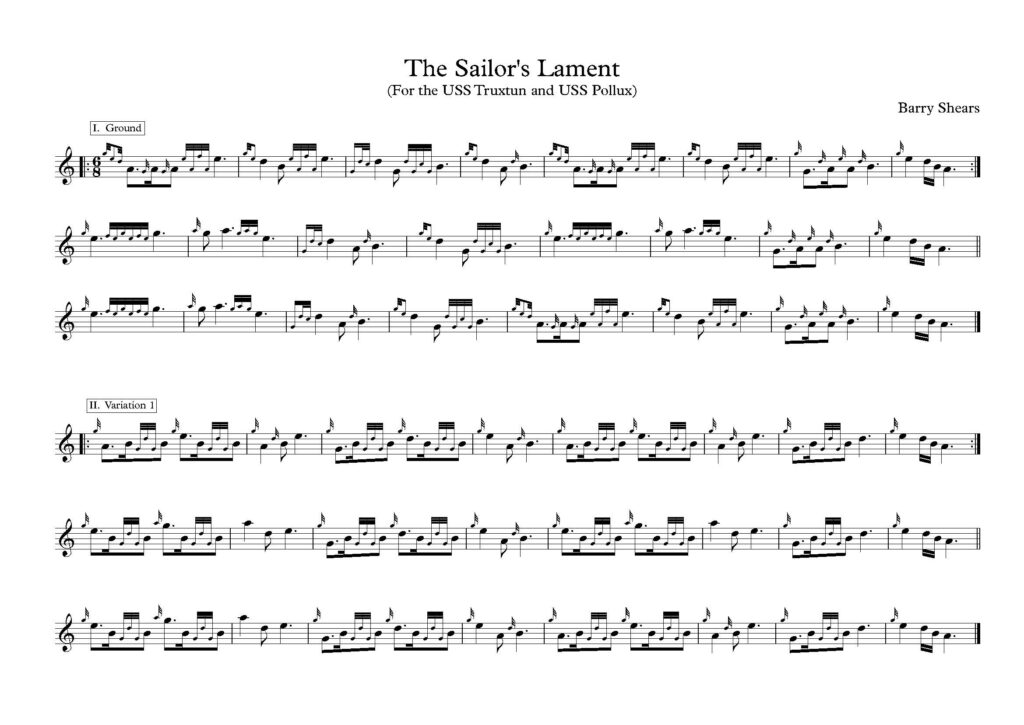
This week saw the anniversary of a shipping disaster which cost the lives of more than 200 US sailors. The tragic story of the USS Truxtun and USS Pollux has inspired a piobaireachd from Barry Shears, the well known piper of Cape Breton. It was commissioned by the Shasta Piping Society for their upcoming collection of modern piobaireachd…..
The story of the USS Truxtun and USS Pollux is tragic one, and most likely not well known to most pipers. The ships were part of a small convoy of three ships sailing to the United States base in Argentia, Newfoundland, when they were overtaken by a fierce winter storm and grounded on Newfoundland’s rugged south coast. In all, 203 men perished, and the disaster is considered one of the worst in American naval history.

By Barry Shears
Newfoundland-Labrador was a colony of Great Britain until 1949, when it became the tenth province in the Dominion of Canada. Because of its position in the North Atlantic, Newfoundland was of vital strategic importance since it was the closest part of North America to Europe. During the Second World War Newfoundland was the site of three US bases, Argentia, St Johns and Stephenville. To better protect North America from a possible German invasion Britain and the United States decided to fortify several areas of the colony. The bases were built in the 1940s under an agreement between Britain and the US to allow ‘the establishment of military bases in exchange for 50 aging destroyers’, a much-needed boost to the war effort against Nazi Germany.
In February 1942 three vessels set sail from Maine and Boston, two destroyers the USS Truxtun and USS Wilkes, and a supply vessel the USS Pollux, delivering supplies to the Argentia base. A combination of factors, radio silence due to marauding U-boats, and increasingly unstable radio communication and navigation due to poor weather, combined to drive the ships off course. All three were ultimately grounded at various locations on Newfoundland’s rugged and rocky south coast. The Wilkes managed to free herself with minimal damage, but the other ships were hung up on rocks, their hulls pierced, pounded by an ever increasingly violent sea.

The USS Truxtun was a four-stack destroyer, already over 20 years old when it met its fateful end on February 18, 1942. She went aground at Chambers Cove early in the morning and her crew suffered the most casualties. Many of the sailors were young men with little experience, and in an effort to make it to land they jumped into the water attempting to swim to shore. The waves carried some out to sea, while others were fatally smashed against rocks and high sea cliffs. Still more froze to death after reaching land.
One sailor managed to get to shore, scale the cliffs and walk several miles to a mine site close to the town of St. Lawrence. Word went out through the community that a vessel was in trouble and several residents packed ropes, picks, axes and food, and proceeded to the site.
The men of St Lawrence waded into the frigid water to help sailors who managed to get close to shore and over the next several hours carried semi-conscious men up the ice-covered cliffs and back to a make shift hospital at the Iron Springs Mine where the survivors were bathed and fed, and provided with warm dry clothes donated by the community.
Despite the best efforts and courage of the men on board and the rescuers, of the 156 men on board only 46 survived. For days afterwards the Newfoundlanders were involved in recovering bodies and body parts which continued to wash up on the shore.

A similar fate awaited the men on board the newly commissioned supply ship, the USS Pollux. Like the Wilkes and Truxtun, the USS Pollux lost its way and was driven ashore. During this voyage the Pollux carried not only a full complement of 159 officers and crew, but also 58 new recruits en route to Newfoundland for training, and 16 passengers. As a supply ship it was carrying bombs, radio equipment, aircraft engines and other supplies. During the winter storm the Pollux had become separated from the other ships and ran aground on the rocks at Lawn Point, a mile and half from where the Truxtun was beginning to break apart.
Lifeboats were launched in an effort to reach shore only to be smashed to pieces by the crushing waves. The USS Wilkes came to the aid of the Pollux and tried to send in lifeboats but the waves were too high and these too were splintered by the force of the sea. Due to the high waves and strong currents the USS Wilkes could then do little but stand by and watch. A few men managed to eventually get to shore but as the ship began to break apart over 100 men slipped into the water to try and swim to safety. Many perished a few minutes after leaving the vessel. Some were smashed against the rocks, as others drowned from the faulty use of life jackets, their lifeless bodies bobbing around in the water with their arms held upright, their heads underwater.
A rescue party of eight men came from the tiny outport of Lawn and helped the sailors who had managed to get to shore, and they were later joined by men from St Lawrence who had already assisted the sailors of the Truxtun. When the ordeal was over 140 men had been rescued. These survivors too were taken to Iron Springs Mine and cared for. Despite the loss of 203 men the story of the USS Truxtun and Pollux is not just one of hopelessness, despair and death, but also one of courage, compassion and survival.
The urlar of this piobaireachd uses the older form of the ‘eallach’ in its opening passage and each line ends with an older form of cadence based on the playing of pibroch songs on the bagpipe from Cape Breton. The rest of the variations, two in 6/8 rhythm, represent the back forth motion of the waves smashing against the unfortunate ships and crew and the many attempts at rescue, finishing with the rescue of some of sailors represented by the crunluath breabach variation.

The Composer
Barry Shears is an acknowledged expert on the history of traditional piping in Nova Scotia and its intrinsic connection to the Gaelic language, music and culture of the province. He is an award-winning musician and has performed at festivals and concerts throughout North America and Europe. He holds the Canadian Armed Forces (Reserve) Pipe Major’s Certificate, the Senior Pipers Certificate and Teachers Certificate from the Institute of Piping in Scotland, and has won the Champion Supreme trophy for professional piping in Nova Scotia six times.
Barry’s list of publications include The Gathering of the Clans Collection, Volumes One and Two; The Cape Breton Collection of Bagpipe Music; and most recently Dance to the Piper: The Highland Bagpipe in Nova Scotia, a book of history based on his Master of Arts thesis from Saint Mary’s University in Halifax. A fifth collection of history, photos, Puirt a Beul and 249 tunes entitled Play It Like You Sing It, Volumes One and Two were published in 2018.
Since retiring from competitive piping in 1986, Barry spends much of his spare time researching Nova Scotia’s extensive piping history, collecting traditional pipe music and piping related paraphernalia, composing and arranging, performing at concerts and dances, adjudicating piping competitions, and teaching and lecturing on Cape Breton dance music both at home and abroad. Barry’s grandfather was a Newfoundlander who came from Newfoundland early last century to work in the coal mines of Cape Breton. His grandmother, Mary Ellen Walsh, was from the small community of Lawn, mentioned in this article.
Barry has been studying and playing piobaireachd for almost 50 years. His first lessons were through the Canadian military, and later through recordings of Donald Macleod, Donald MacPherson and Sandy Boyd, a pupil of John MacColl and Robert Reid who came to Cape Breton during World War Two. In 1978, while living in Edinburgh for three and half months, Barry had piobaireachd lessons from Captain Andrew Pitkeathly, Edinburgh Castle, and in 1984 he competed for the Silver Medal at Oban.

















What a beautiful lament. Can I ask Barry if the last 2 notes of each line in the crunluath are deliberately low G? Elsewhere in the tune it is low A. I do like the low G – it seems entirely fitting.
Thanks for the kind words,
I did play the last two notes as A when I first wrote it but after revisiting the tune after a few weeks the change was made to Low G since I liked the contrast (as well a few other last minute edits). I was looking for subtle ways to make make the tune unique and when I naturally played the two Low Gs on a revisit it seems to make sense to my ear. Having said that, staff notation is just a guide and if folks want to play it with two Low A’s that works for me too.
all the best Barry
This is so awesome, thanks so much for doing this.I can’t wait to hear this lament on the pipes.